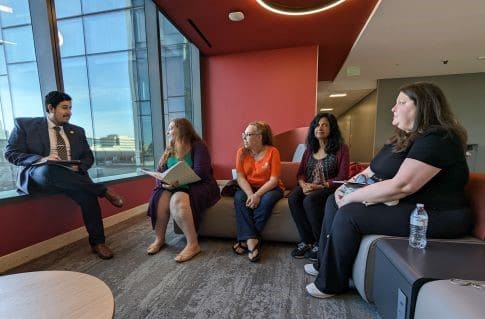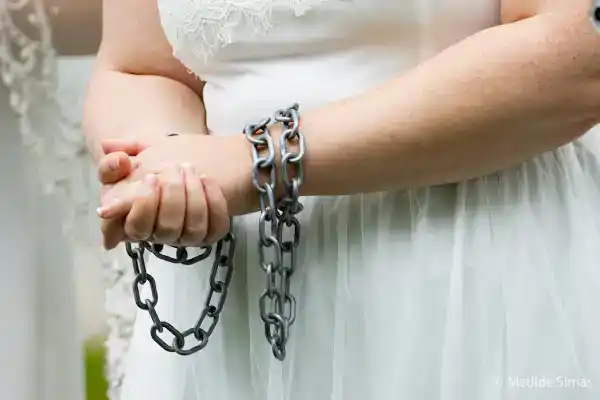By Unchained At Last
September 2025
Last updated September 22, 2025
Unchained At Last is a survivor-led nonprofit organization working to end forced and child marriage in the United States through direct services and systems change.
FOREWORD
By Dr. Chelsea Clinton, Vice Chair of the Clinton Foundation As a mom, public health advocate and American citizen, I am gravely concerned about the archaic, sexist and deeply harmful practice of child marriage.
As a mom, public health advocate and American citizen, I am gravely concerned about the archaic, sexist and deeply harmful practice of child marriage.
While the repercussions of the child marriage crisis are not exclusive to girls and young women, they disproportionately affect them. It’s estimated that, each year, 12 million girls around the world are married before they turn 18. The perception that child marriage is something that happens to other kids in other places – not the United States – is a false one. Between 2000 and 2021, nearly 315,000 children were legally entered into marriage across the U.S. The vast majority were girls wed to adult men.
It is unconscionable and indefensible that child marriage persists in the 21st century. To continue to make progress in protecting kids, banning child marriage and supporting survivors, we need to know the painful statistics of who is most affected and their stories. This report, painstakingly researched and written by Unchained At Last, gives us that unflinching look at the harm caused by child marriage and a path forward to ensuring that no child in America is ever married.
The findings and personal histories highlighted in this report further support what we’ve known for some time now – that child marriage undermines bodily autonomy; has devastating consequences for health, education and economic opportunity; and traps young people in cycles of poverty and abuse, denying them agency over their own futures.
As this sobering report makes clear, child marriage also creates legal loopholes by undermining statutory rape laws, facilitating human trafficking and leaving children without the rights they deserve and need to navigate or escape a marriage contract. Regardless of how mature minors are, they simply do not have the legal rights necessary to navigate a contract as serious as marriage.
The United States should be a leader in the global movement to end child marriage, and we should start at home. Thanks in large part to organizations like Unchained At Last and its partners, we have made progress. Within the last decade, 16 states, the District of Columbia and two U.S. territories have passed legislation to prohibit child marriage. The U.S. has pledged, under United Nations Sustainable Development Goal 5.3, to ban child marriage nationwide by the year 2030. Keeping that promise is within our reach, but there is more work to be done, and we must be united and indefatigable in our efforts.
I hope this report will serve as both a warning and a call to action. At a time when human rights – especially women’s and girls’ rights – are being rolled back around the world, it is more important than ever that we stand together as advocates, lawmakers, survivors and allies to close legal loopholes, ban child marriage everywhere and protect the rights of girls where we can, defend them where we must and advance them wherever possible.
Introduction
Child marriage, defined as a formal marriage or informal union before the age of 18,1 is legally permitted in the vast majority of the United States. 2 Marriage age in the U.S. is set by each state, and, as of September 2025, only 16 out of 50 states have set the minimum age at 18 without exceptions – and those states did so only in the last few years. Four states – California, Mississippi, New Mexico and Oklahoma – do not specify any minimum age at all.3 This leaves hundreds of thousands of children vulnerable to abuse, exploitation and lifelong harm.
2 Marriage age in the U.S. is set by each state, and, as of September 2025, only 16 out of 50 states have set the minimum age at 18 without exceptions – and those states did so only in the last few years. Four states – California, Mississippi, New Mexico and Oklahoma – do not specify any minimum age at all.3 This leaves hundreds of thousands of children vulnerable to abuse, exploitation and lifelong harm.
Child marriage is recognized globally as a profound manifestation of gender inequality and gender-based violence.4 It disproportionately affects girls, with wide-ranging consequences for their rights to education, to the highest attainable standard of health, including sexual and reproductive health, to protection from violence and to freedom from sexual exploitation and abuse.5
The U.S. is obligated to address child marriage under the international human rights treaties it has ratified, including the International Covenant on Civil and Political Rights.6 Yet the country continues to fail to uphold its obligations. In 2023, the United Nations Human Rights Committee expressed concern that child marriage remained legal in most of the U.S., and it urged the U.S. to “adopt measures at all levels in order to prohibit marriage under the age of 18.”7
Legal reform must be guided by up-to-date, credible evidence. Yet there is no federal requirement for states to collect or report marriage certificate data, and there is no central repository for such data. Many states either do not track this information or significantly limit public access to it. This lack of transparency has made it historically difficult to assess the true scope of early marriages in the U.S.
The lack of comprehensive data is not just a technical gap but a significant barrier to change. Regular collection of nationwide, disaggregated data on the prevalence of child marriage is necessary to support resource allocation, design survivor-centered interventions, evaluate the impact of legal reforms and hold governments accountable for inaction. Data drives visibility, which is essential for public and political will. In the absence of data, child marriage and its impact on hundreds of thousands of girls remain in the dark.
This report seeks to address that gap. It builds upon Unchained At Last’s previous, groundbreaking research, first published in the Journal of Adolescent Health in 2021.8 That research found that some 297,033 children were legally married in the U.S. between 2000 and 2018, based on marriage certificate data and extrapolated estimates. This updated analysis presents new prevalence data from across the country, offering a more complete and current picture of how widespread the issue remains.
Since Unchained issued its 2021 report, the U.S. has seen meaningful progress. All told, 16 U.S. states and one district – home to nearly 10.8 million girls – as well as two territories have heeded the calls of Unchained and its allies to enact simple, commonsense laws to address child marriage.9 Public awareness of the issue is growing. However, the data presented here makes it clear that child marriage is far from eradicated. By providing updated, disaggregated prevalence data, this report aims to support targeted policy change, inform survivor support strategies and close the gap between legal commitments and lived realities in the U.S.

Mandy’s mother encouraged her to become affectionate with the man from their church in Arizona who was showing an interest in Mandy.
He was aged 18. Mandy was 12.
His grooming and abuse continued for years, fully sanctioned by Mandy’s mother, who spoke of God’s plan. He proposed to her four years later, and she tried to say no. After exhausting every possible way to escape what her parents were forcing her to do, she ran away, but as a minor, she had no power. Her parents were able to force her back home and into marriage.
Mandy was married a week after her 17th birthday to her 23-year-old longtime rapist and abuser.
She was trapped in a marriage marked by relentless emotional, physical, verbal and financial abuse.
When Mandy finally escaped as an adult, at age 20, she was excommunicated from her church. She lost all her family and friends. She was left to rebuild her life on her own.

Methodology
No central repository in the U.S. tracks ages at marriage to determine the extent of child marriage. With this study, Unchained is creating that repository.
Unchained requested marriage certificate data from all 50 U.S. states and the District of Columbia. Specifically, Unchained asked each state’s health department (or other agency responsible) for de-identified data on the ages and genders of all people married in the state, along with their spouse’s age and gender, in each year since 2000.
Unchained used statistical analysis software to analyze the data and answer key questions, including: How many minors were legally entered into marriage in each state, and nationally, between 2000 and 2021? What were their ages and genders? What were their spouses’ ages and genders? How many underage marriages occurred at an age or with a spousal age difference that should have been considered a sex crime?
FULL DATA
Thirty-three U.S. states provided marriage certificate (or, in some states, marriage license) data that showed the age or age ranges of all individuals married each year between 2000 and 2021. For those states, Unchained analyzed the provided data to determine the number of individuals who married before age 18. (Some states provided data for years after 2021 as well, but those years are not included in the national calculations presented in this report.)
Note that this analysis looked at minors married, not child marriages. Thus, any marriage in which two minors married each other is counted as two married minors.
Vital statistics agencies take different approaches to data management and privacy. In some states, these approaches almost certainly mean the findings in this report are an undercount. For example, Tennessee withheld all cross-tabulated cell counts less than 10, such as if nine 17-year-olds married 20-year-olds in a given year, potentially hiding thousands of additional child marriages. (Unchained counted each withheld cell as one, to be conservative.) Ohio randomly and irretrievably deleted data on children married before age 15 in most years. Additionally, some states’ data included nonsensical marriage ages, such as three-digit numbers, that Unchained excluded from analysis.
PARTIAL DATA – MISSING YEARS
U.S. states and the District of Columbia provided marriage-age data for some or most of the years 2000 to 2021. Since the number of minors married in each state is highly correlated across years, Unchained used each of those states’ available years of data and national trends to estimate the numbers for the missing years.
In states that have set the minimum age for marriage at 18 without exceptions, Unchained estimated the number of minors wed until the month the legislation went into effect, after which time Unchained presumed zero minors were married.
PARTIAL DATA – MISSING JURISDICTIONS
Three states, Arizona, New York and Nevada, provided complete marriage-age data from one or more jurisdictions that represented a significant proportion of the state population. Unchained estimated the number of minors wed in the missing jurisdictions based on the rate of child marriage in the jurisdictions with available data and the proportion of minors who live in the missing jurisdictions. (Sometimes these states also were missing some years, for which Unchained estimated the data using the method described above for state data with missing years.)
NO DATA
Six U.S. states have never provided any marriage-age data. Unchained estimated the number of minors wed in those states based on the median rate of child marriage across the U.S. and the number of minors who live in each of the six states.
For states that banned child marriage, Unchained estimated the number of minors wed until the month the legislation went into effect, after which time Unchained assumed zero minors were married.
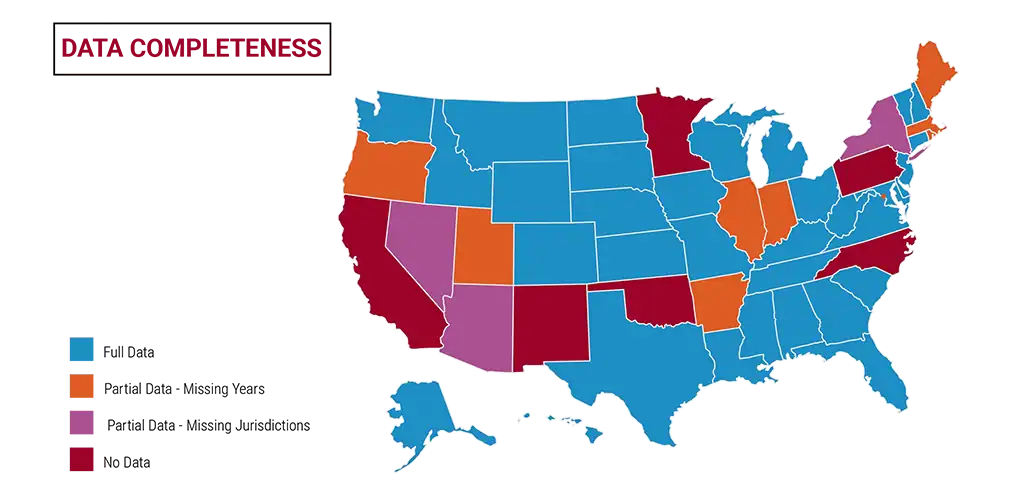
Key Findings
An estimated 314,154 minors were legally entered into marriage in the U.S. between 2000 and 2021. An overwhelming majority – some 86% – were girls, and most were wed to adult men an average of 4.02 years their senior.
Nearly all the minors wed – some 96% – were aged 16 or 17, but some were as young as 10.10

Many were not old enough to consent to sex with their spouse. At least 66,415 marriages occurred at an age or with a spousal age difference that should have been considered a sex crime.11 Nearly all of those marriages, about 90% of them, represented a “get out of jail free” card for a would-be child rapist, due to state laws that allow within marriage what would otherwise be considered statutory rape. The other 10% involved a minor who was sent home to be raped: The marriages were legal, but sex within those marriages was considered a sex crime under the relevant states’ laws.
Nationally, the number of minors wed decreased every year after 2001 until 2021, during the COVID-19 pandemic, when it increased by 3.8%.
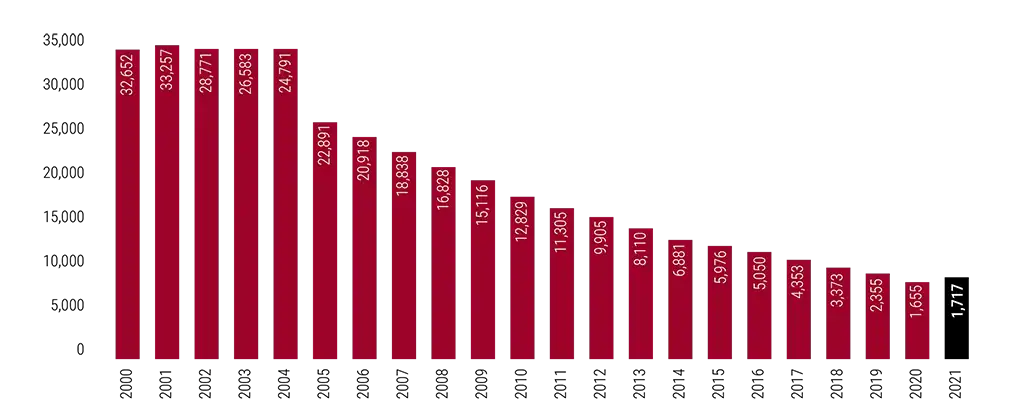
The only states where numbers reached and stayed at zero were those that passed legislation to make the marriage age 18, no exceptions. Child marriages continued to occur in states that passed legislation to increase the marriage age to a number lower than 18 or to add “safeguards” to the process of marrying off a minor, such as requiring judicial approval and/or limiting the spousal age difference.
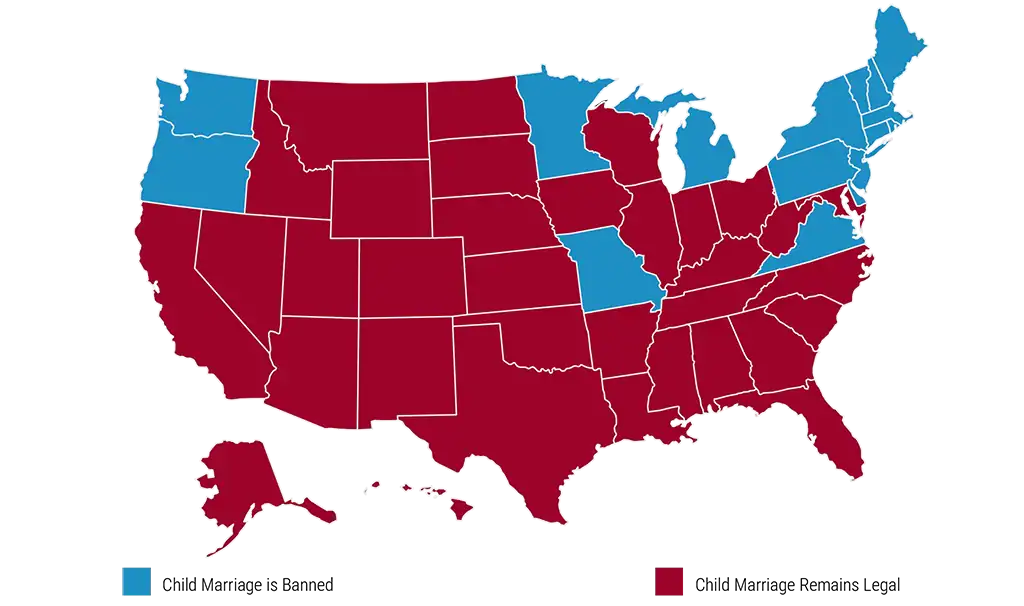
The average rate of child marriage among states with available data was 2.03 per 1,000 girls and .31 per 1,000 boys. The overall average rate of child marriage among those states was 1.13 per 1,000 minors.12
The three states with the highest rates of child marriage were Nevada, Idaho and Utah.
| STATE | AVG RATE PER 1,000 |
|---|---|
| Nevada | 6.154044167 |
| Idaho | 3.563465579 |
| Utah | 3.227908086 |
| Kentucky | 2.976682653 |
| Wyoming | 2.546109579 |
| West Virginia | 2.405746227 |
| Alabama | 2.218431162 |
| Mississippi | 1.947511426 |
| Tennessee | 1.85043157 |
| Texas | 1.73758334 |
| Missouri | 1.510280931 |
| Oregon | 1.416662775 |
| South Carolina | 1.393201965 |
| Kansas | 1.376793518 |
| Arkansas | 1.270327713 |
| STATE | AVG RATE PER 1,000 |
|---|---|
| Colorado | 1.266544726 |
| Georgia | 1.197122077 |
| Alaska | 1.164939404 |
| Virginia | 1.160657121 |
| Florida | 1.159535645 |
| Arizona | 1.14725547 |
| Louisiana | 1.139605511 |
| South Dakota | 1.096816579 |
| Washington | 0.8556142835 |
| Indiana | 0.8116608818 |
| Illinois | 0.7721858908 |
| Hawaii | 0.7711857763 |
| Nebraska | 0.7621626933 |
| Maryland | 0.7069319308 |
| Wisconsin | 0.5782438483 |
| STATE | AVG RATE PER 1,000 |
|---|---|
| Michigan | 0.5690984742 |
| North Dakota | 0.5456824547 |
| Montana | 0.5389033719 |
| Vermont | 0.5151848801 |
| Iowa | 0.4981636474 |
| Ohio | 0.4676354026 |
| Connecticut | 0.3895041883 |
| New Jersey | 0.2884787771 |
| Delaware | 0.28842946 |
| New York | 0.2553396103 |
| Massachusetts | 0.2367180539 |
| District of Columbia | 0.2230311311 |
| Maine | 0.1828645245 |
| New Hampshire | 0.1776598935 |
| Rhode Island | 0.1164260969 |


At Carol’s request, the photo used here is not actually of her.
Carol was pregnant when she was married in Kentucky. At age 14. To her 20-year-old rapist.
The man had groomed Carol from when she was 12, before she even knew how babies were made. He stalked her, raped her in the backseat of his car and put a ring on her finger, claiming her as “his.” He continued assaulting her for two years – and when she got pregnant, he threatened that if she did not marry him, he would go to prison for rape, and she would end up in state custody. He told her neither of them would survive.
Carol sobbed openly on her wedding day. No one intervened. No one even asked her why.
For the next five years, Carol’s husband brutally raped her, abused her and neglected her and their children. He forced her to withdraw from school and withheld even the most basic of necessities. She was a child without the rights or resources necessary to escape.
Carol eventually managed to leave after five years, when she was an adult. But she left with three children, an eighth-grade education and severe post-traumatic stress disorder. She still has not fully recovered.
“What did that 20-year-old man take away from that 14-year-old girl?” she asked. “Everything.”
Impact of Covid
The COVID-19 pandemic had far-reaching consequences for human rights globally, including in the U.S.13 In the aftermath of nationwide lockdowns, school closures and widespread economic downturns, child marriage became an increasingly visible outcome of systemic stress, especially for already vulnerable children.14
In 2021, an estimated 1,782 minors were entered into marriage in the U.S., marking an increase of 3.8% from the previous year – even though the national number of minors entered into marriage had previously decreased every year after 2001. This unusual and alarming shift suggests pandemic-related stressors, including housing insecurity, financial hardship, disruptions to education and reduced access to social services,15 might have made more parents decide to marry off their children.
At the same time, social isolation made it more difficult for minors to report abuse or seek help.16 School personnel, social workers and mandated reporters, who often serve as the first line of protection, became exponentially less accessible during periods of remote learning and institutional shutdowns.
These developments in the U.S. mirror global patterns observed during the pandemic. In 2021, UNICEF warned that up to 10 million more girls around the world would be at risk of child marriage as a result of COVID-19 and its aftereffects.17
The pandemic served as a stark reminder of how crises exacerbate pre-existing inequalities. For children in the U.S. already vulnerable to early marriage, COVID-19 compounded risk factors and reduced pathways to intervention. These findings underscore the critical need for consistent legal protections, reliable data collection and resilient social systems capable of identifying and responding to child marriage, particularly in times of crisis.

Pat was 12 years old when she called a crisis hotline for help. The counselor she reached “counseled” her twice a week – while he also raped and groomed her.
She got pregnant when she was 13. And she was married to her 28-year-old rapist when she was 14, so as not to bring “shame” to her family.
For 14 months after an Alabama judge approved her marriage, Pat juggled attending junior high school, keeping house and trying to keep herself and her baby alive around a man who grew more violent every day.
Her parents refused to help her. And she was too young to drive, get a job, rent an apartment. She was stuck until a court-appointed advocate agreed to help her seek a divorce. After her divorce, Pat made it back to school in time for 11th-grade English class.
But Pat continued to struggle with alcoholism, depression and chronic post-traumatic stress disorder. Her relationship with her parents never recovered, and, as a teen without a support system, she made the excruciating decision to give her child up for adoption.
The pain of that decision continues to torment her now, nearly four decades later.

Policy Recommendations
As this study makes clear, child marriage remains a serious issue in the U.S. But the solution is well within reach. Sixteen states, one district and two territories have already taken action by passing clear laws that set the minimum marriage age at 18, no exceptions. Every remaining state and territory must follow suit. In the three U.S. states where the legal age of adulthood is higher than 18, marriage laws should be aligned accordingly to ensure consistent safeguards for all minors.
Passing such legislation costs nothing, harms no one (except those who prey on children) and eliminates a human rights abuse.
Ending child marriage in the U.S. will require these and other actions by every U.S. state, as well as actions by the federal government, civil society and the international community – as laid out in the separate policy memo that Unchained co-authored in response to this study in partnership with the international human rights organization Equality Now.
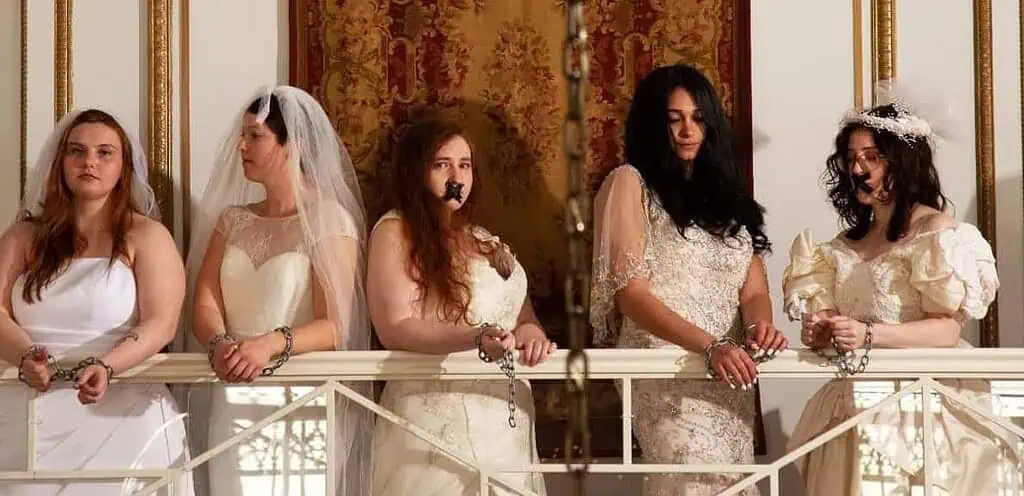
Acknowledgments
This study was made possible by the dedication and collaboration of many individuals – particularly Fraidy Reiss, Becca Powell, Alex Boyer Coffey and Rebecca Wilkin of Unchained At Last, and Anastasia Law, Divya Srinivasan, Fareeha Ali Yahya and Mel Bailey of Equality Now.
Dr. Alissa Koski and Kaya Van Roost of McGill University led the data management and statistical analyses for this study. Mariana Edelman Photography & Design designed this report.
Heartfelt thanks go to the survivors who bravely shared their stories to illustrate the study findings, and to Chelsea Clinton for her powerful foreword.
This study built on a previous report Unchained released in 2021, titled “United States’ Child Marriage Problem: Study Findings,” that was made possible by funding from the Bill & Melinda Gates Foundation and partnership from McGill University, Quest Research & Investigations, Kroll, Quantitative Analysis, J Strategies, White & Case, TrustLaw, DLA Piper, Morgan Lewis and DOSIDO Design.
References
- 1. Equality Now, Child Marriage, https://equalitynow.org/child-marriage/. ↩︎
- 2. Unchained At Last, Child Marriage in the U.S., https://www.unchainedatlast.org/child-marriage-in-the-u-s/. ↩︎
- 3. Id. ↩︎
- 4. United Nations Office of the High Commissioner for Human Rights (OHCHR), Harmful Practices, https://www.ohchr.org/en/women/harmful-practices. ↩︎
- 5. United States Agency for International Development, Child, Early, and Forced Marriage Resource Guide (September 2015), https://banyanglobal.com/wp-content/uploads/2017/05/USAID_CEFM_Resource-Guide.pdf. See also: Rachel Kidman, Child Marriage and Intimate Partner Violence: A Comparative Study of 34 Countries, International Journal of Epidemiology (April 2017), https://academic.oup.com/ije/article/46/2/662/2417355; Gordon B. Dahl, Early Teen Marriage and Future Poverty, Demography (1 August 2010), https://www.ncbi.nlm.nih.gov/pmc/articles/PMC3000061/; Mara Steinhaus and Lyric Thompson, No Exceptions: A Synthesis of Evidence on the Prevalence and Impact of Child and Early Marriage in the United States and How This Compares to Existing Global Evidence, International Center for Research on Women (2020), https://www.icrw.org/publications/child-marriage-in-the-united-states-a-synthesis-of-evidence-on-the-prevalence-impact/; Aditi Wahi, et al., The Lived Experience of Child Marriage in the United States, Social Work Public Health (12 February 2019), https://pubmed.ncbi.nlm.nih.gov/30747055. ↩︎
- 6. OHCHR, International Covenant on Civil and Political Rights (19 December 1966), https://www.ohchr.org/en/instruments-mechanisms/instruments/international-covenant-civil-and-political-rights. ↩︎
- 7. United Nations Human Rights Committee, Concluding Observations on the Fifth Periodic Report of the United States of America (3 November 2023), https://www.eracoalition.org/uploads/2023/11/CCPR_C_USA_CO_5_56540_E.pdf. ↩︎
- 8. Fraidy Reiss, Child Marriage in the United States: Prevalence and Implications, Journal of Adolescent Health (December 2021), https://www.jahonline.org/article/S1054-139X(21)00341-4/fulltext. ↩︎
- 9. Unchained At Last, Child Marriage in the U.S., https://www.unchainedatlast.org/child-marriage-in-the-u-s/. ↩︎
- 10. Age breakdown excludes estimated data and excludes state data provided without specific ages. ↩︎
- 11. The analysis of marriages that met the definition of sex crimes excluded all imputed data except California’s and excluded Kansas, whose data format precluded such analysis. California’s estimates were included because that state’s age of consent to sex is 18 and its marriage age is 0. For this analysis, Unchained assumed California’s rate of child marriage, and its proportion of child marriages that involve two minors, is average. For Texas, this analysis covered only 2000 to 2017, due to data anomalies. ↩︎
- 12. Child marriage rates are for minors aged 15 to 17. They were calculated based on the state that issued each marriage license (not the state of residence) and the issuing state’s population. ↩︎
- 13. United Nations Sustainable Development Group, COVID-19 and Human Rights (April 2020), https://unsdg.un.org/sites/default/files/2020-04/COVID-19-and-Human-Rights.pdf. ↩︎
- 14. United Nations Children’s Fund (UNICEF), COVID-19: A Threat to Progress Against Child Marriage (7 March 2021), https://data.unicef.org/resources/covid-19-a-threat-to-progress-against-child-marriage/. ↩︎
- 15. United Nations Sustainable Development Group, COVID-19 and Human Rights (April 2020), https://unsdg.un.org/sites/default/files/2020-04/COVID-19-and-Human-Rights.pdf. ↩︎
- 16. Christina M. Rodriguez, et al., The Perfect Storm: Hidden Risk of Child Maltreatment During the Covid-19 Pandemic, Child Maltreatment (23 December 2020), https://pmc.ncbi.nlm.nih.gov/articles/PMC8093016/. ↩︎
- 17. UNICEF, COVID-19: A Threat to Progress Against Child Marriage (7 March 2021), https://data.unicef.org/resources/covid-19-a-threat-to-progress-against-child-marriage/. ↩︎
This report updates Unchained’s previous report issued in 2021. Read that report here.




